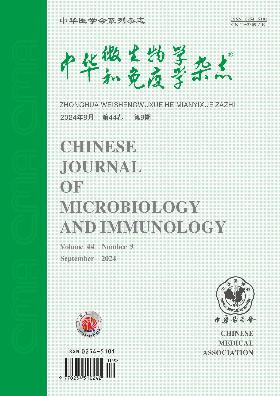Nano-emulsion as a vaccine adjuvant can enhance the humoral immunity against influenza in aged and young mice
Q4 Immunology and Microbiology
引用次数: 0
Abstract
Objective To evaluate the immunogenicity of split influenza H1N1 vaccine formulated with an oil-in-water nano-emulsion adjuvant in aged mice and young mice. Methods A nano-emulsion adjuvant formulated split influenza H1N1 vaccine was used to immunize aged and young mice through intramuscular injection. Each mouse was immunized with 0.012 μg of hemagglutinin (HA) twice with an interval of 28 d. Hemagglutination inhibition (HI) titers in serum were measured 27 d after first immunization. Serum HI, IgG1 and IgG2a titers were detected 14 d after the last immunization. No adjuvant-formulated vaccine and normal saline (NS) were used to set up control groups. Virus challenge test was carried out using 10 times the median lethal dose (LD50) of A/Puerto Rico/8/34 (H1N1) strain two weeks after the last immunization and the protective effects were assessed through measuring the dynamic changes in body weight and survival rate. Results Higher levels of serum HI, IgG1 and IgG2a antibodies and higher HI antibody conversion rates were induced in the adjuvant groups, especially in the aged mice group, than in the control groups. Nano-emulsion adjuvant improved the immunogenicity of HA and mouse immunity to A/Puerto Rico/8/34 (H1N1). Conclusions Nano-emulsion adjuvant could enhance the immunogenicity of influenza antigens, especially in aged mice. Key words: Adjuvant; Influenza; Nano-emulsion adjuvant; Aged mice; Immunogenicity纳米乳剂作为疫苗佐剂可增强老年和青年小鼠对流感的体液免疫
目的评价水包油纳米乳剂佐剂配制的甲型H1N1流感裂解疫苗对老年小鼠和青年小鼠的免疫原性。方法采用纳米乳剂佐剂配制的甲型H1N1流感裂解疫苗,通过肌内注射的方法免疫老年小鼠和青年小鼠。每只小鼠用0.012μg血凝素(HA)免疫两次,间隔28天。第一次免疫后27天测量血清中的血凝抑制(HI)滴度。最后一次免疫后14d检测血清HI、IgG1和IgG2a滴度。不使用佐剂配制的疫苗和生理盐水(NS)来建立对照组。在最后一次免疫两周后,使用10倍于中位致死剂量(LD50)的A/Puerto Rico/8/34(H1N1)毒株进行病毒激发试验,并通过测量体重和存活率的动态变化来评估保护效果。结果佐剂组血清HI、IgG1和IgG2a抗体水平较高,HI抗体转化率较高,尤其是老年小鼠组。纳米乳液佐剂提高了HA的免疫原性和小鼠对A/Puerto Rico/8/34(H1N1)的免疫力。结论纳米乳剂佐剂能增强流感抗原的免疫原性,尤其对老年小鼠免疫原性增强。关键词:佐剂;流感;纳米乳液助剂;衰老小鼠;免疫原性
本文章由计算机程序翻译,如有差异,请以英文原文为准。
求助全文
约1分钟内获得全文
求助全文
来源期刊

中华微生物学和免疫学杂志
Immunology and Microbiology-Virology
CiteScore
0.50
自引率
0.00%
发文量
6906
期刊介绍:
Chinese Journal of Microbiology and Immunology established in 1981. It is one of the series of journal sponsored by Chinese Medical Association. The aim of this journal is to spread and exchange the scientific achievements and practical experience in order to promote the development of medical microbiology and immunology. Its main contents comprise academic thesis, brief reports, reviews, summaries, news of meetings, book reviews and trends of home and abroad in this field. The distinguishing feature of the journal is to give the priority to the reports on the research of basic theory, and take account of the reports on clinical and practical skills.
 求助内容:
求助内容: 应助结果提醒方式:
应助结果提醒方式:


